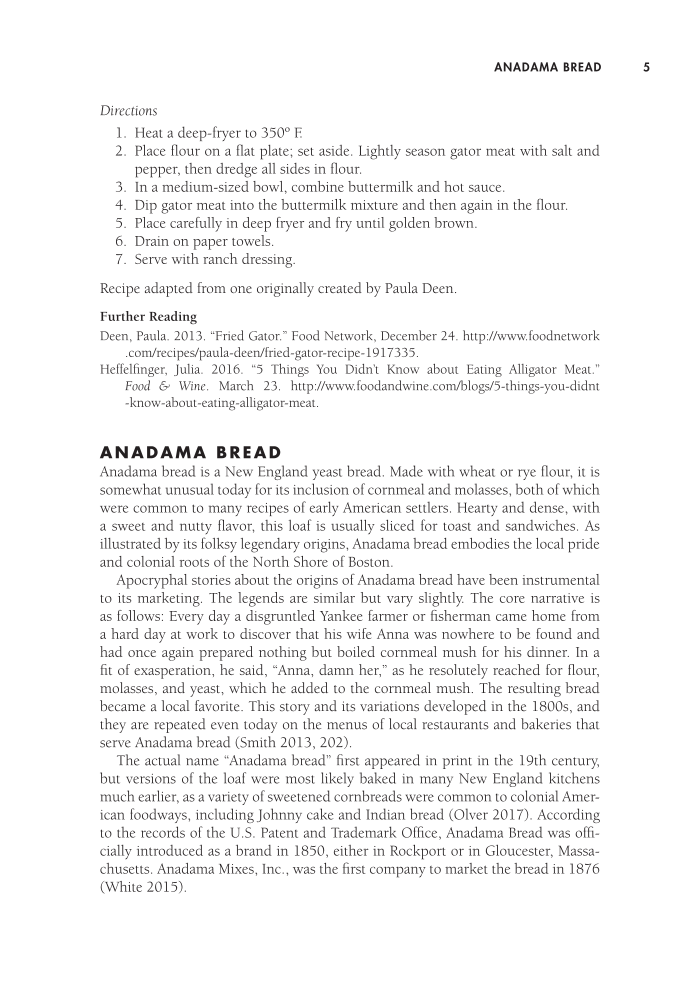anaDAMA BREAD 5 Directions 1. Heat a deep-fryer to 350º F. 2. Place flour on a flat plate set aside. Lightly season gator meat with salt and pepper, then dredge all sides in flour. 3. In a medium-sized bowl, combine buttermilk and hot sauce. 4. Dip gator meat into the buttermilk mixture and then again in the flour. 5. Place carefully in deep fryer and fry until golden brown. 6. Drain on paper towels. 7. Serve with ranch dressing. Recipe adapted from one originally created by Paula Deen. Further Reading Deen, Paula. 2013. “Fried Gator.” Food Network, December 24. http://www.foodnetwork .com/recipes/paula-deen/fried-gator-recipe-1917335. Heffelfinger, Julia. 2016. “5 Things You Didn’t Know about Eating Alligator Meat.” Food & Wine. March 23. http://www.foodandwine.com/blogs/5-things-you-didnt -know-about-eating-alligator-meat. ANADAMA BREAD Anadama bread is a New England yeast bread. Made with wheat or rye flour, it is somewhat unusual today for its inclusion of cornmeal and molasses, both of which were common to many recipes of early American settlers. Hearty and dense, with a sweet and nutty flavor, this loaf is usually sliced for toast and sandwiches. As illustrated by its folksy legendary origins, Anadama bread embodies the local pride and colonial roots of the North Shore of Boston. Apocryphal stories about the origins of Anadama bread have been instrumental to its marketing. The legends are similar but vary slightly. The core narrative is as follows: Every day a disgruntled Yankee farmer or fisherman came home from a hard day at work to discover that his wife Anna was nowhere to be found and had once again prepared nothing but boiled cornmeal mush for his dinner. In a fit of exasperation, he said, “Anna, damn her,” as he resolutely reached for flour, molasses, and yeast, which he added to the cornmeal mush. The resulting bread became a local favorite. This story and its variations developed in the 1800s, and they are repeated even today on the menus of local restaurants and bakeries that serve Anadama bread (Smith 2013, 202). The actual name “Anadama bread” first appeared in print in the 19th century, but versions of the loaf were most likely baked in many New England kitchens much earlier, as a variety of sweetened cornbreads were common to colonial Amer- ican foodways, including Johnny cake and Indian bread (Olver 2017). According to the records of the U.S. Patent and Trademark Office, Anadama Bread was offi- cially introduced as a brand in 1850, either in Rockport or in Gloucester, Massa- chusetts. Anadama Mixes, Inc., was the first company to market the bread in 1876 (White 2015).
Document Details My Account Print multiple pages
Print
You have printed 0 times in the last 24 hours.
Your print count will reset on at .
You may print 0 more time(s) before then.
You may print a maximum of 0 pages at a time.




































































































































































































































































































































































